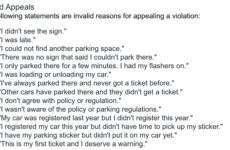By: Mary Cate Kelleher
Posted In: Campus News
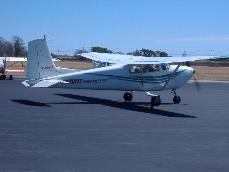
Photo credit: Katie Harrington
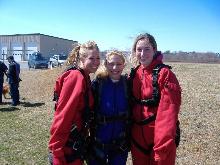
Photo credit: Katie Harrington
Mary Cate Kelleher (right) and friends Ally and Jess all suited up.
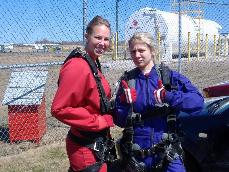
Photo credit: Katie Harrington
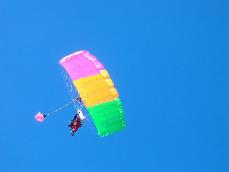
Photo credit: Katie Harrington
NEWPORT – Without missing a beat Andreas told me to move towards the door, and as I did my legs were immediately suctioned outside the plane. He instructed me to place my feet on the platform just outside the door and he settled in behind me. One…two…three…
We rolled out of the plane ,and I immediately felt an adrenaline rush. Together we did a frontward roll, and then I spread out into the “banana-shape” that we were shown in our brief ground-training, spine curved concavely with arms and legs splayed. The wind seemed to rush right through my body, and as we fell 5,000 feet at 120 miles per hour, the ground never appeared to get any closer. Having ignored the advice of owner Marc Tripari, I didn’t wear gloves ,and as a result I began to notice that my hands were cold, but it was pushed to the recesses of my mind as I looked out over the golden expanse of land beneath me. I felt Andreas pull the cord to the parachute and we jolted slightly as it filled with air. A DAREDEVIL’S DREAM? I had wanted to go skydiving since high school, and it never seemed like a real possibility until college, when my friend and fellow psychopath asked if I wanted to go with her and her family and several of their friends. I immediately signed on, paid the deposit and started to mentally prepare myself for what I thought lay ahead. As fate would have it another friend of mine chose that particular day in August to have her wedding, and my skydiving plans were cancelled so I could attend her nuptials. I spent two years since then feeling simultaneous extreme disappointment that I missed out on my skydiving adventure and guilt that I was so hesitant to cancel on what was possibly the most important day of my friend’s life. And now here we were, me and the three friends I had dragged along, preparing to jump out of a plane. My friend Ally Post and I had been discussing skydiving since last fall when I decided I absolutely had to do it before graduation, and she agreed to come with me. Sky Dive Newport’s season opens up on April Fools’ Day, and on a superstitious whim we chose April 2 as our day. I spent the next 5 months trying to convince everyone I know to come with us and in the end it came down to myself, Ally and her roommate Jessica Verna. My roommate, Katie Harrington, the only one of us to not jump, came along for moral support and was, ironically, the most nervous out of all of us. “I thought that I would go there with three friends, and I would leave there with none,” she said. “I mean, what if the parachutes didn’t open?” Natural fears for sure. I suppose a lot of people entertained these same thoughts when I would ask them to come with me and received an emphatic “No.” For some reason, these concerns never crossed my mind. I just wanted to jump out of a plane. According to the United States Parachute Association’s (USPA) website, there were 1,275 injuries reported that required medical attention in 2002. That same year there were 33 fatal accidents resulting from skydiving. The most recent information reports 21 fatalities in 2004. Katie wasn’t the only person who was scared of what might happen. Both of my parents told me they didn’t want to hear about it until I had landed safely on the ground. Ally’s mother said the same thing. Jess didn’t even tell her parents she was going, and decided in the end that the best way to tell them would be to mail them the “First Jump Certificate” each of us received after our landing. SKYDIVE NEWPORT Skydive Newport, located at the Newport State Airport in Middletown, has an impeccable safety record. Owner Marc Tripari said there has never been an accident at Skydive Newport since it opened in 1999 and cited safety as one of the things that sets Skydive Newport apart from a lot of other skydiving centers. The other perks of our chosen location were, as Tripari put it: their professionalism, an experienced staff, the location, which is not only one of only six skydive centers in New England but also the only one that’s not landlocked, and the drug and alcohol regulations that are strictly enforced. Tripari explained the 30-minute training period that included 15 minutes of paperwork and 15 minutes preparing prospective jumpers for what lay ahead. The training session includes things like body position and landing position, and they keep the focus on having fun. For the most part they only allow tandem jumps, which means that no one jumps without an instructor. They offer a Student Training Program on a limited basis, which would prepare you for a solo jump. This requires six hours of ground training, and, according to Tripari, most places don’t offer this option. Tripari takes pride in Sky Dive Newport’s casual, low-stress environment, describing the clients as “passengers” for the instructor. “Some places offer complete training that overwhelms them [the jumpers],” he said. “We don’t want them to feel like they failed because they didn’t open the parachute.” FROM JUMPSUITS TO LIABILITY “I want to wear the pink one.” Jess stood between two rows of chairs in the waiting area of Skydive Newport, observing a collection of multi-colored jumpsuits hanging on a rack in the corner. Clearly they were part of the uniform we would soon be wearing as we hurdled toward the ground with nothing between us and certain death but a parachute and, thankfully, a well-trained instructor. We filled out our Release of Liability forms on the red chairs that were lined up in a manner similar to that of an airport terminal. We laughed nervously at the rights we were waiving, such as number seven, the “spectator’s covenant” which states: “…I COVENANT AND AGREE as follows: In consideration of my being allowed to witness or observe the Parachuting Activities of my friend, relative or family member, or in consideration of being allowed to enter upon or remain upon the premises or facilities of any Released Party for such purpose, I hereby WIAVE AND RELEASE and all claim(s) of every kind and nature which I may have, or may hereafter have, arising from my friend’s, relative’s or family member’s Parachuting Activities, including specifically but without limitation any claim or claims for or on account of loss of consortium, loss of economic support, negligent infliction of emotional distress, emotional distress or other loss.” Signing away this right as well as being forced to acknowledge the possibility of death earlier on in the document was by no means funny, but we laughed nonetheless. When our forms were signed and initialed, we brought them up to the front desk where we paid the early-season special fee of $200. Once back in our chairs, a tall man with dirty blond hair named Andreas came over and briefed our group and the one that was to jump before us on what our day would entail. He spoke with a thick eastern European accent that made it difficult to understand some of what he said, but he had an easy manner about him that seemed to put everyone in the room at ease. You could tell that he’d been doing this for a long time and understood the nervous anticipation that most first-time jumpers feel at this point in their experience. He explained what we would be wearing, how the parachute works, how fast we would be going during our 60-second freefall, the safety measures that would be taken and the position we would have to take when we came close to landing. The most settling piece of information was his description of the Automatic Activation Device which, according to the USPA website, “calculates the rate of descent and altitude and deploys either the main or reserve canopy at a preset altitude.” So for example, should your instructor have a stroke during the freefall the parachute would open on its own before both of you crashed fatally to the ground. The plane, which is according to Skydive Newport’s website a Cessna 182 with Wing Extensions, only fits two tandem teams at a time, and since our group contained only three jumpers one of us had to join the group ahead of ours to even out the numbers. Having been the ringleader and the least nervous I volunteered to leave the comfort of my friends and suit-up with a middle-aged woman named Mary who had come with her daughter and son-in-law. We each wriggled into matching red jumpsuits, and then stepped into the black harnesses that would attach us to our instructors and parachutes. We wandered outside to the fenced-in landing area to watch the others in Mary’s group land. Watching them fall from the sky was surreal. Tiny specks suddenly appeared outside of the plane and sped toward the ground at an alarming rate. The free-fall seemed to last for several minutes rather than the designated 45 – 60 seconds. We all breathed a sigh of relief when we saw the neon pink parachutes burst open at the half-way point between the plane and the ground. After the landing Andreas and the other instructor, Jeremy, AKA “The Flying Dutchman,” according to the nickname embroidered on his navy blue jumpsuit, picked up the parachutes and brought them inside to be rolled back up and packed for another jump. Mary and I headed inside to await our turn, and before we knew it we were stepping into the tiniest plane I have ever seen. Andreas instructed me to climb in and sit with my back against the pilot’s chair. He climbed in after me and we sat facing each other with our legs inter-lacing. Mary sat next to me and Jeremy behind her, next to the pilot. He immediately began harnessing himself to her, and the plane headed down the runway before the hatch door was pulled shut. When I commented on the tight fit, Andreas replied, “You should see it when we get a 250-pound guy in here.” AQUIDNECK ISLAND FROM 10,000 FEET The flight was longer than I expected it to be and I thoroughly enjoyed it. From 10,000 feet I could see all of Aquidneck Island and I took in the sights while the pilot found a good spot to let us loose. I found First and Second beaches, the Breakers mansion, which was still enormous from the high altitude, Memorial Avenue and the patch of neighborhood between Thames and Spring Street that most of Salve Regina University’s upper-classmen call home. Andreas had me turn around so he could harness himself to me and Mary, and I put on our protective goggles. As I admired the Newport Bridge and the expanse of ocean to the east one more time, Jeremy re-opened the hatch door, Mary and I smiled at each other and before I knew it they were gone. I had expected more time between the moment when Mary jumped and when I would. Instead, Andreas immediately told me it was time and go and pushed me toward the door. I suppose if I had had more time to think about it the knot in my stomach would have expanded beyond the marble that it was. In the brief moment that I sat in the doorway of the plane, my legs forcibly placed on the platform outside, the possible danger of what I was doing finally occurred to me. And then we were falling. On our way down Andreas asked me if all the straps holding me were comfortable, if they weren’t he could loosen them and I told him I was fine. He pointed to Mary and Jeremy floating down ahead of us at a distance. We practiced the landing position in the air one more time so I would feel comfortable doing it when the time came. I was extremely calm. I didn’t appreciate it at the time but there was a serene silence as we floated through the air. Aside from the sparse conversation between me and Andreas the sky was still and quiet and in retrospect reminds me even more of a kind of ocean than it ever has. WHAT HAPPENED TO THE ADRENALINE RUSH? Even though the free-fall had lasted longer than I thought it would, I was disappointed when it was over because I never got the rush I was expecting. I’ve heard it said that the thrill of skydiving is comparable to sex, if not better, and I hadn’t felt anything quite so dramatic. “Sounds like you need a stronger dose,” said Dr. Kenneth Melvin, a retired professor of psychology at the University of Alabama. “Try it a couple of times, maybe [try] a longer free-fall.” Melvin still teaches a course at the University of Alabama called “The Psychology of Motivation” and discusses the ideas of psychologists Frank Farley and Richard Solomon when asked about what motivates people to seek out potentially life-threatening activities like skydiving. According to Melvin, I am probably a Type-T personality, the T standing for thrill-seeker. “There are some types of people who seek out excitement,” he said. “It could be gambling or taking drugs, but they’re not all bad. Some may wind up to be bank robbers while some others might be entrepreneurs.” Melvin said that some people are satisfied with the stimulation that occurs with everyday life and don’t need that extra arousal, while thrill-seekers may need some escape from life. A study done specifically on skydivers revealed that they are more prone to other risky behaviors like smoking, drinking and gambling. Melvin has also studied the theory of pain and pleasure to find out why people seek out painful events. Citing Farley, he contrasted skydiving and drug use, saying that with drugs you start out with a pleasurable experience but they become less pleasurable over time and the after-effects are bad. Skydiving is the opposite. The fear that some people experience before the initial jump can be considered the pain aspect, but the after-effects are really great. “You start off with a steady state of emotion,” he said. “Then you get a high. When you come down you sink below baseline and the after-effect is the opposite emotion than you started with.” Melvin cited a 1960s Epstein study of military parachutists that found “even a brave man on a first jump feels fearful, but after several jumps it changes a bit to excitement.” An interview with repeat jumper Nick Santarelli confirms this idea. Having gone four times it was his last jump that proved to be the most stimulating. All four jumps have been tandem, but since his comfort level has significantly increased since the first time he jumped he was able to exit the plane into five back flips and end in a nosedive before opening the parachute. The free fall, which typically ranges anywhere from 45 seconds to a minute, lasted only 13 seconds. “I hit the ground 10 minutes before anyone else,” he said. “It was awesome.” According to Santarelli the fastest-clocked nosedive was at 270 miles per hour. “They tell you not to breathe,” he said. “The air comes in so fast. I had the hiccups when I hit the ground.” Santarelli describes the repeated tandem jumps as “addictive” but thinks that going solo has a more spiritual aspect to it. Nothing compares to the adrenaline rush. “Every time I look at the sky, I just want to be floating,” he said. “It’s the ultimate freedom.” After his first jump Santarelli decided that he wanted to become certified and he took a class in which he did an hour’s worth of training. His second jump was to test the skills he learned in the training, and the instructor was only there for guidance. “The second jump freaked me out more than the first,” he said. “I was more nervous because I wanted to pass it.” As of right now his goal to be certified has been put on hold for financial purposes, but he’s still optimistic and has considered pursuing skydiving as a career. “It’s not completely unattainable.I’ve thought about it a lot,” he said. Still, Santarelli admits that skydiving isn’t for everybody. “There’s a certain mentality that goes with it,” he said. “Either you like it, or you’re like, ‘What the hell am I doing?’ But there’s not a skydiver out there that doesn’t think you wouldn’t enjoy it.” ON THE GROUND AGAIN As we came closer to the landing area I saw Katie, Ally and Jess standing as close as they were allowed and waving as they cheered me on. Andreas instructed me to lift my legs into the sitting position we had practiced and we swept into the ground smoothly. The landing was incredibly soft, and I sat on the ground for a minute so I could take in all that I had just experienced. Andreas detached himself and the parachute, Mary and I congratulated each other and we headed back to our respective groups. Jess and Ally were all dressed and ready to go, Jess wearing purple instead of the desired pink and Ally in red. I went back inside to undress as they prepared to climb into the plane. Jeremy asked Jess if she had any questions before they went. “No. I just don’t want to die,” Jess said. And they were off. Later, as we sat in my living room and re-hashed the experience, I asked Ally what the most exhilarating part of her day was. Of the three of us she had the most ecstatic landing. “Once I hit the ground, I wanted to go back up again,” she said. “If I had another $200, I would.” She said that as a result of this experience she wouldn’t be afraid to try something new. “I never thought I would jump out of a plane,” she said. “If I’m presented with another opportunity [like this one] I would try it.” I would have to say that I agree. Having already made plans to go skydiving again this summer, I am more than willing to try something else that’s not only new, but more extreme. Still feeling a little heart-broken over my less-than-life-changing skydiving experience I’m ready for one of those 13-second nosedive jumps Nick Santarelli is talking about. We were sprawled out on the couches in my living room exhausted and watching the news. Katie, having felt slight pangs of regret for not jumping, pointed to the TV at a man in a wet suit being lowered into the ocean in a cage to go swimming with sharks. The newscast flashed ahead to a view of the cage being rushed at by a great white, and my heart skipped a beat in nervous anticipation for the man inside. “That’s what I want to do,” she said. Totally. Where do I sign up?
